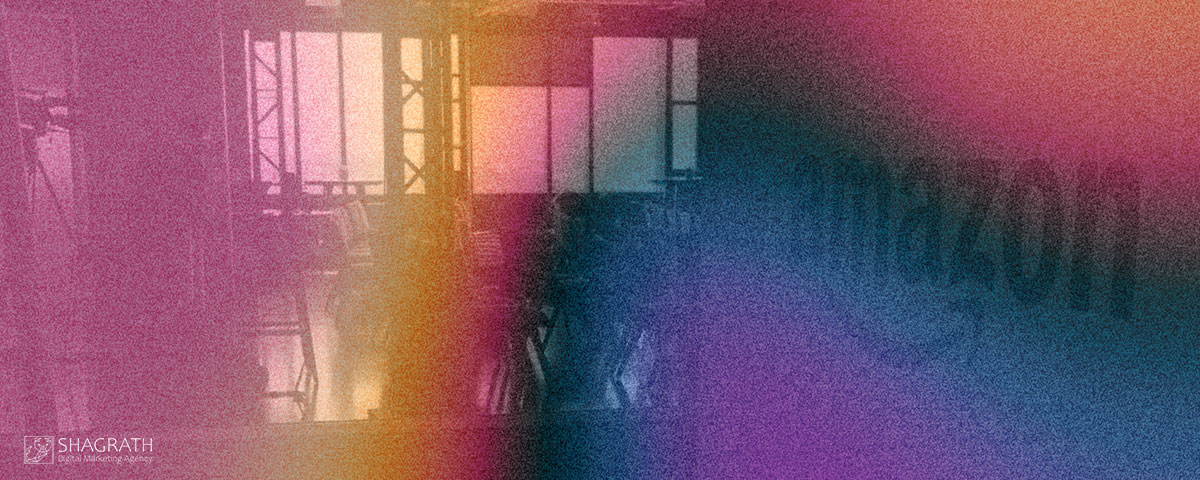
Personalization Absolutely Fits All!
April 20, 2024
How Shagrath Make Your Visual Identity Absolutely Shine
June 15, 2024Stay Ahead with a Flexible Brand

Business executives often believe in stability through longer product life cycles and market changes. However, branding is constantly changing, and adapting to client demands is crucial. To meet client demands, flexibility must be ingrained in all essential aspects of the business and brand. Designers face challenges in creating flexible brands that effectively transition across various environments, leading to many big names adopting new, flatter, stripped-back logos to ensure success in both online and real life. Last year’s biggest rebrands showcased simplified redesigns as brands need flexibility for digital and traditional touchpoints. Flat logos are more flexible and help maintain consistency, especially with 3D elements and embellishment.
Creating a Flexible Brand

The most effective brand architecture is intuitive, cohesive, and allows organizations to launch new products or services. Agile brand architecture balances coherence with adaptability, ensuring sustained relevance amid evolving consumer values. Take Google, for instance. While the Google master brand ties its growing product ecosystem together, the tech giant creates new sub-brands when entering entirely new segments such as FitBit in the tech health segment and Nest in the tech security sector.
Architects have discovered that designing flexible buildings can reduce the amount of damage that landslides, storms, and seismic activity can inflict. The same rules hold true for your brand. Future revenue streams will be maximised and structural risk will be reduced by creating flexible brand blueprints.
Nostalgic Feeling in Flexible Brands

It’s interesting to observe which brands have embraced nostalgia in tandem with the trend of designers simplifying everything to the essentials. While the two may seem contradictory, when they work together, the combination tends to offset any potential personality loss that a minimalist design may have. Burger King’s recent rebrand, featuring a simple, rounded burger shape, retro color palette, and 70’s feel, has received praise for its nostalgic and forward-thinking aesthetic.
Flexible Brands to the Future

We believe that popular brands will keep undergoing the minimalist makeover in the future. It would be interesting to observe how well-known brands handle this transition while maintaining a connection with their consumers. It’s reasonable to argue that branding is more important than ever. Furthermore, having a strong and dependable online and offline presence depends on building a flexible brand.
What is a flexible brand?
A brand is considered flexible if its visual identity and marketing approach are easily modified to align with changing consumer demands, the company’s evolving core values, and its overall focus in a dynamic market. Many businesses should understand why it’s critical to have a robust and adaptable brand, yet they often don’t.
Why should all care about brand flexibility?

First and foremost, as your business grows, you must include this growth into your content strategy and make sure the images match. It’s important to keep your company values in mind while you expand and consider new goods. It’s important to make sure your objectives line up and, if not, adjust the ones that already exist.
New items or services are not usually readily apparent from the outside. You aren’t taking advantage of new strengths if you aren’t utilizing these adjustments. You can simply modify and adjust your content strategy, brand imagery, and values when your brand is adaptable. A flexible brand saves time and frustration by allowing for easy adaptation as your company expands, without the need to start from scratch, making expansion and growth faster.
Developing Flexible Brand for Company Growth

To create a successful brand, identify your product or service’s main goals, define key messages, and refine your content strategy. Analyze and position your messages to reflect consumers’ needs. Design and development teams must also consider strategy. A flexible visual brand starts with a design system that reflects the brand’s strategy. Maintain consistency by focusing on communication between designers, developers, and content producers. Collaborate meetings with different teams to assess brand strategy through multiple skill lenses. Brand flexibility is crucial for a company’s growth and standing out in an evolving marketplace.
Adapting go-to-market tactics

If you were encouraged by the framework to challenge established tactics, how might your brand appear? It can be necessary to reevaluate a strategy that hasn’t been tried in a long time. When it comes to strategically bringing offerings to market, brand agility is crucial. It could be necessary to rethink what made growth possible in the past due to disruptive factors and changing consumer behavior. Strict adherence to antiquated go-to-market (GTM) approaches runs the danger of letting up to more flexible rivals.
A national or international campaign comes with a hefty cost, particularly if the desired outcomes are not achieved. Brands have the option to first test large-scale product introductions in small settings, saving a hefty upfront cost. Prior to allocating a sizable investment to a broad rollout, concentrate on optimizing methods for specific consumer groups by segmenting by geography, demographics, or other distinct variables. Before releasing a product widely, brands test the market to give themselves the opportunity to adjust their strategy based on feedback and improve upon successful strategies. Creating a flexible “test small, scale bigger” capacity for GTM activities and the related positioning is crucial. This could appear as:
• Exploring New Distribution Channels
• Aligning with rising buyer preferences.
• Experimenting with emerging promotion levers.
• Optimizing marketing mix for highest traction areas.
• Customizing messaging tones and content formats.

Amazon’s MVP product launch cycle, based on user feedback, is an example of flexible GTM strategies. This approach allows for targeted pilots to optimize tactics before expanding to broader reach. Brands can nurture innovation by running small-scale experiments and investing resources in winning concepts. For legacy brands, refreshing their brand during transformational phases can be crucial. JPMorgan, a digital brand, transformed its digital presence and funded cutting-edge capabilities. As cryptocurrencies gained popularity, JPM launched crypto services for clients. As sustainable investing gained traction, JPM created climate policy teams to guide clients through decarbonization journeys. By constantly scanning for paradigm shifts and leveraging its brand strength, JPMorgan embodied brand dexterity.
Internal Flexibility

Ant colonies are effective societies, with worker ants providing defense, food, and nest building. Brands can learn from their worker ants by deep listening to customers, fostering trust, openness, and nurturing relationships. Staff should have the freedom to assert their judgment, encourage dialogue, and take ownership of customer experiences.
Flexible Brand Culture Steps

• Listening to staff and customer feedback for strategy guidance.
• Encouraging experimentation for decisive response to shifts.
• Informed brand strategy from both bottom-up and top-down perspectives.
• Adapting brand purpose to align with employee and consumer priorities.
Items and sales will come and go. However, internal empathy feeds into the responsive assistance consumers value from companies that win their enduring loyalty. Including flexibility into your brand’s core areas will create a proactive engagement strategy and a long-term growth environment for your company.



